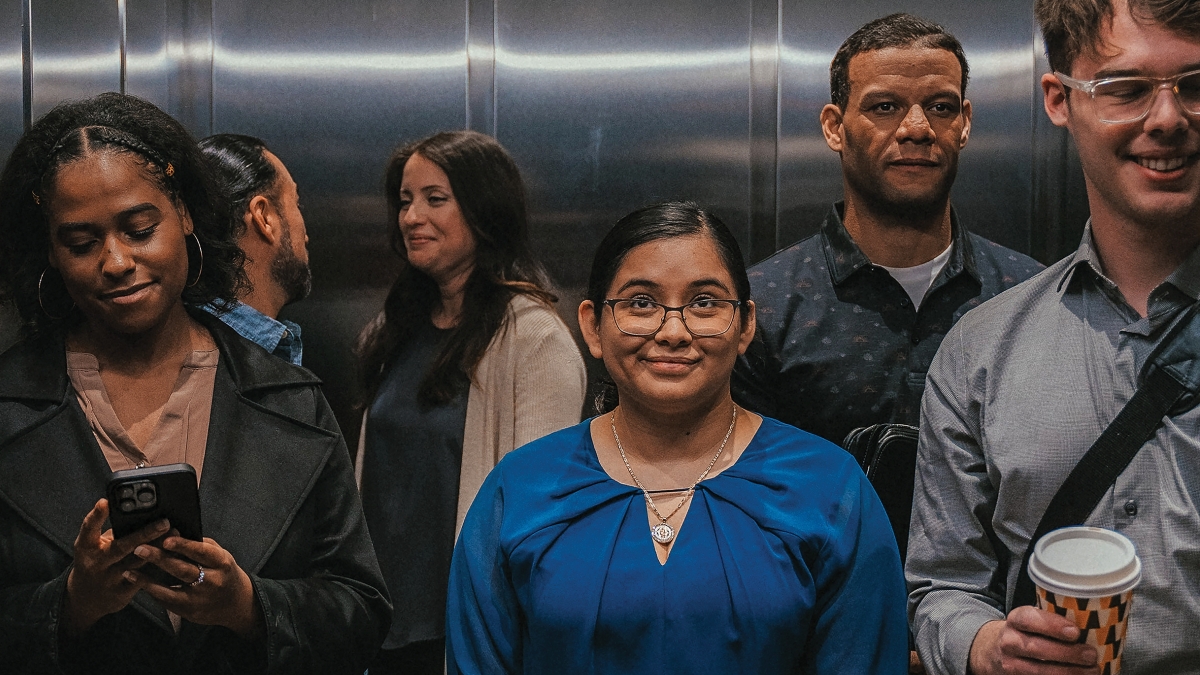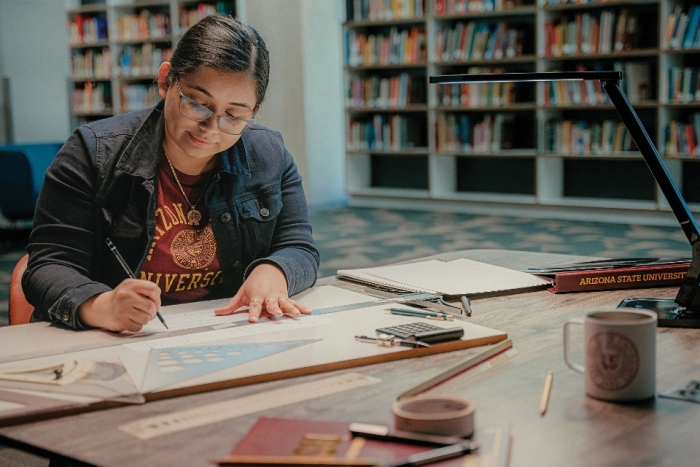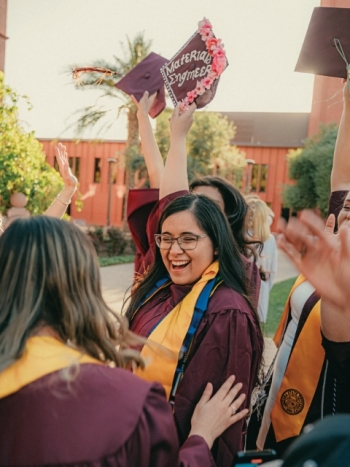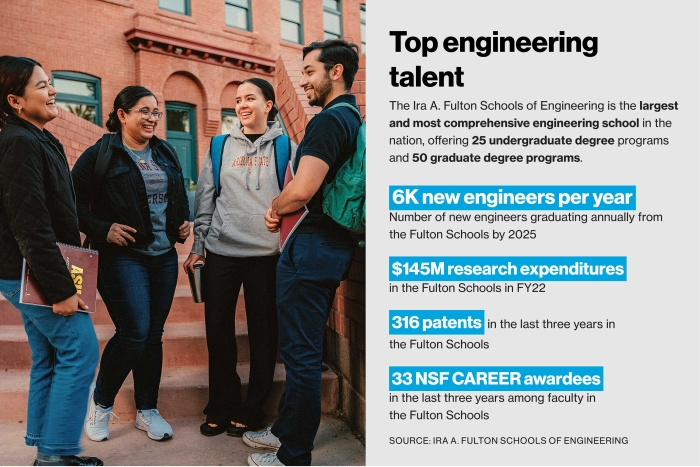Editor's note: This story originally appeared in the summer 2024 issue of ASU Thrive magazine.
On an overcast day in Oregon in 2021, Cindy Rogel Bahena, ’21 BSE in materials science and engineering, walked into Intel’s Aloha Factory Operations Far Back End factory to start her day as a wafer fabrication process engineer on the quality control and manufacturing floor.
Rogel Bahena works on a team that creates the tools to develop advanced, tiny semiconductor microchips 10 years into the future.
“I love my work because I help create measurements and a new system of management of projects and work with other technicians to create the best protocol and bring the highest quality for products across the world,” Rogel Bahena says.
“I create recipes on the tool and work with the automation to implement and ensure that if any troubleshooting is needed, it’s communicated effectively through procedures that I write,” she says.
Semiconductors power devices around the world. Everything that switches on and off uses a semiconductor of some kind. Some of the most complicated electronics, like many computers and phones, use Intel’s chips.
The road to Intel
At a young age, Rogel Bahena knew she wanted to do something that would impact her community and help the world become a better place.
“I heard ‘engineer,’ and it sounded fun, so I gave it a shot,” she says.
Rogel Bahena is the oldest of seven siblings and the first in her family to go to college. She graduated with honors. English was not her first language and she had no Latina role models to use as examples of engineers, but ASU helped support her in her goals.
Rogel Bahena first connected with ASU when she was at Barry Goldwater High School, not far from the Tempe campus. The Joaquin Bustoz Math-Science Honors Program is a math camp created to help talented students from underrepresented groups gain credits and support for college-level math. Selected students in the top 5% of their class can participate in the summer camp program with a scholarship. With the other students, Rogel Bahena attended classes for college credits on the Tempe campus with professors and tutors.
“I lived on campus for three summers and met so many other engineers, former ASU staff and alumni with similar backgrounds,” she says.
“This experience made me feel comfortable about the transition to college, and it was the right space for me to grow with a community of highly excelling students,” Rogel Bahena says. “Because of this experience, there weren’t any other serious college considerations for me because I already had a built-in community at ASU.
“Now, I am a tutor in the program from afar,” she says.
Seeking help
Rogel Bahena says a key to her success is her relationships with mentors, both now and during college. One impactful experience, she says, was talking with Professor Seth Tongay, chair and professor of materials science and engineering at ASU, who told her she was indeed smart enough to become an engineer — never to doubt that — and helped provide extra tutoring so she could master the math and engineering concepts.
Meanwhile, Carrie Robinson, executive director of graduate student and scholar success, helped provide Latino role models, Rogel Bahena says.
“Women and Latinos are underrepresented in STEM,” Robinson says. “Because Latinas are less likely to see people who look like them as students in their classes, as instructors and in industry, it’s important to be deliberate about how we as university faculty and staff make those connections.”
Mentors at ASU share their experiences, offer advice for success and provide encouragement when underrepresented students hit challenges and barriers, Robinson says.
While at the university, Rogel Bahena joined the Society of Hispanic Professional Engineers student chapter, which she served as president.
“Having people with the same background as me and the mentorships made me feel at home at ASU,” Rogel Bahena says, as did soaking up the knowledge from professors of all backgrounds.
She says she possesses an impressive set of lab skills because of faculty mentors like Shahriar Anwar, research specialist senior in the School for Engineering of Matter, Transport and Energy.
Working together
Collaboration is critical at Intel, and she says her time in the ASU labs developed her collaborative skills.
“When we do lab work at Intel, we’re working with other people on technology that hasn’t come out yet. There has to be a lot of kindness, coaching and feedback in engineering because nobody knows what this stuff is and no one has done it before,” she says. “You have to work together and ask things like ‘Do you think this hypothesis would stand up against the customer’s needs?’”
Rogel Bahena says it was the same at ASU. “You had to quickly learn to set up a collaborative environment in the labs and classes for group projects.”
She emphasized the importance of connecting with others, “because there were so many opportunities at the university. It could be overwhelming, forcing you to share your career aspirations with peers, advisors and professors, and from there, get direction.”
At Intel, Rogel Bahena sometimes goes to colleagues to hear what they know about a subject or problem.
“In my work, I took that experience from ASU and just went and bugged everyone who had been there for 10 to 30 years, and I would ask, ‘How does this work?’ Or, ‘I heard you were the expert on this. This is what I’m trying to do. Tell me more about what you know that can help me solve this,’” Rogel Bahena says.
“Sometimes they would say, ‘I am not an expert but I can teach you what I know,’” Rogel Bahena says. “Honestly, a little secret is that everybody doesn’t necessarily know exactly what they’re doing, so you expect that you are going to find a solution together.”
There has to be a lot of kindness, coaching and feedback in engineering because nobody knows what this stuff is and no one has done it before.
Cindy Rogel Bahena'21 BSE in materials science and engineering
The bunny suit
Semiconductor engineers working with sensitive materials like chips or wafers wear the white bunny lab suit to prevent particles from contaminating the clean work areas where tiny chips, smaller than the width of a hair, are made. Rogel Bahena loved becoming part of that engineering community — but it took finessing to get into the suit.
“I remember having the hardest time having my long hair fit in a cap. My technical mentor sent me to talk to another female process engineer to learn the tricks of the bunny suit,” she says.
The suit was just part of the awe; she recalls how beautiful and expansive the Ocotillo campus was and the first time she saw a semiconductor fabrication site, or “fab,” as part of one of her internships while at ASU.
“The huge fab was intimidating; everything was big and moved so fast with so many protocols,” she says. “There were lasers and sensors that you couldn’t even stand in front of or near since you would trigger an alarm. It was unlike anything I had ever seen before.”
On her first day in her bunny suit at Intel, she said she was lucky enough to see a whole wafer mid-process.
“It was impressive and overwhelming but an amazing feat of human intelligence,” she says.
Inspiring others
From awkward bunny suits and working at Intel to building out her skills in the lab, Rogel Bahena feels like a trailblazer.
“I was the first in my family to graduate — and with honors, a degree, two certifications and other designations with full-ride scholarships,” she says. “I want to be a role model for Latinas who follow in my footsteps.”
As part of her purpose to give back, she translates what engineers do at Intel’s STEM events in local elementary schools. She also uses Spanish to communicate with parents at summer camps sponsored by Intel, where she volunteers as a counselor.
“I was always the quiet engineer learning to speak up for myself and trying to learn to be an extrovert. Seeing the diverse population at ASU with a wide range of interests allowed me to learn and adapt to pursue my different goals in my college years and in my role at Intel today.”
Story by Jennifer Kite-Powell. A senior technology contributor at Forbes.com, Jennifer Kite-Powell was named one of the top 100 women in technology in Europe in 2012, and shortlisted for best tech journalist by the TechCrunch Europas Awards.
More Science and technology

ASU researcher part of team discovering ways to fight drug-resistant bacteria
A new study published in the Science Advances journal featuring Arizona State University researchers has found vulnerabilities in certain strains of bacteria that are antibiotic resistant, just…

ASU student researchers get early, hands-on experience in engineering research
Using computer science to aid endangered species reintroduction, enhance software engineering education and improve semiconductor material performance are just some of the ways Arizona State…

ASU professor honored with prestigious award for being a cybersecurity trailblazer
At first, he thought it was a drill.On Sept. 11, 2001, Gail-Joon Ahn sat in a conference room in Fort Meade, Maryland. The cybersecurity researcher was part of a group that had been invited…




